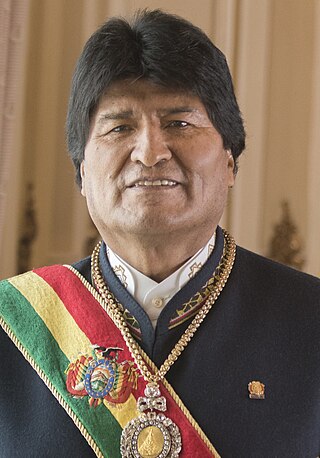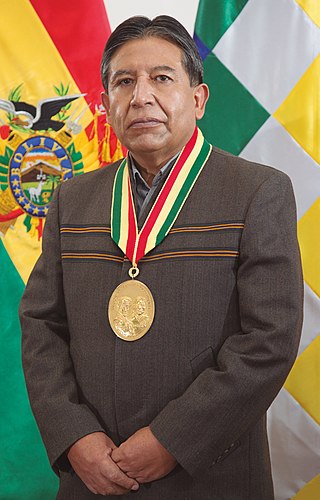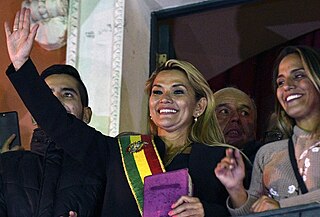
The president of Bolivia, officially known as the president of the Plurinational State of Bolivia, is head of state and head of government of Bolivia and the captain general of the Armed Forces of Bolivia.

Gonzalo Daniel Sánchez de Lozada Sánchez Bustamante, often referred to as Goni, is a Bolivian-American businessman and politician who served as the 61st president of Bolivia from 1993 to 1997 and from 2002 to 2003. A member of the Revolutionary Nationalist Movement (MNR), he previously served as minister of planning and coordination under Víctor Paz Estenssoro and succeeded him as the MNR's national chief in 1990.

Juan Evo Morales Ayma is a Bolivian politician, trade union organizer, and former cocalero activist who served as the 65th president of Bolivia from 2006 to 2019. Widely regarded as the country's first president to come from its indigenous population, his administration worked towards the implementation of left-wing policies, focusing on the legal protections and socioeconomic conditions of Bolivia's previously marginalized indigenous population and combating the political influence of the United States and resource-extracting multinational corporations. Ideologically a socialist, he has led the Movement for Socialism (MAS) party from 1998 to 2024.

David Choquehuanca Céspedes is a Bolivian diplomat, peasant leader, politician, and trade unionist serving as the 39th vice president of Bolivia since 2020. A member of the Movement for Socialism, he previously served as minister of foreign affairs from 2006 to 2017 and as secretary general of ALBA from 2017 to 2019.

The Bolivian Palace of Government, better known as Palacio Quemado, was the official residence of the President of Bolivia from 1853 to 2018 and again briefly from 2019 to 2020. It is located in downtown La Paz on Plaza Murillo, next to the La Paz Cathedral and across from the Bolivian legislature. On 9 August 2018, it was replaced by the Casa Grande del Pueblo as the residence of the president by President Evo Morales. The interim government of Jeanine Áñez briefly reverted to occupying the Palacio Quemado from 2019 until 2020 when the newly elected Luis Arce returned to using the Casa Grande. It now serves as a museum.

The Ministry of Cultures, Decolonization, and Depatriarchalization is the ministry of the government of Bolivia that provides for the preservation and protection of the cultures and artistic expressions of the indigenous peoples of Bolivia as well as promotes the country's tourism sector and process of decolonization and depatriarchalization.

Luis Alberto Arce Catacora, often referred to as Lucho, is a Bolivian banker, economist, and politician serving as the 67th president of Bolivia since 2020. A member of the Movement for Socialism, he previously served as minister of finance—later minister of economy and public finance—from 2006 to 2017, and in 2019.

Esther Morales Ayma de Willacarani was a Bolivian grocer, businesswoman and political activist. In 2006, she was designated to the role of First Lady of Bolivia by her younger brother, then-President of Bolivia Evo Morales, who was unmarried.

General elections were held in Bolivia on 20 October 2019. Voters elected all 130 members of the Chamber of Deputies and 36 senators and cast ballots for a joint slate of president and vice president. The Bolivian constitution allows the President and Vice-President to put themselves forward for re-election only once, limiting the number of terms to two, and the elections took place after in 2016 a referendum to amend the constitution was rejected, but that the Supreme Court of Justice ruled that all public offices would have no term limits despite what was established in the constitution and allowing Morales to run for a fourth term.

Antonia Wilma Alanoca Mamani is a Bolivian journalist, politician, and television presenter who served as minister of cultures and tourism from 2017 to 2019. A member of the Movement for Socialism, she previously served an El Alto municipal councilor from 2015 to 2017, a position she returned to in 2021.

The 2019 Bolivian political crisis was a period of intense political upheaval and unrest in Bolivia that followed the disputed 2019 Bolivian general election, in which incumbent President Evo Morales was initially declared the winner. Morales had run for a controversial fourth term despite having recently lost a constitutional referendum to remove presidential term limits. His bid for reelection was enabled after the Supreme Court then struck down the term limits. The election and the results were heavily contested, with protests occurring across the country as the opposition and many sectors of society alleged that the vote count was manipulated to favor Morales.

General elections were held in Bolivia on 18 October 2020 for President, Vice-President, and all seats in both the Senate and Chamber of Deputies. Luis Arce of the Movement for Socialism (MAS) party was elected president in a landslide, winning 55% of the vote and securing majorities in both chambers of the Plurinational Legislative Assembly. The results of the election superseded the disputed results of the October 2019 elections, which were annulled during a prolonged political crisis.

The flag of the patujú flower is a flag used at official events of the Bolivia government, which shows Bolivia's national flower. The latter represents the indigenous peoples of Eastern Bolivia and has been used as a symbol of protest against the construction of a highway in TIPNIS by the opponents of Evo Morales in that area of the country.

The 2021 Bolivian regional elections were held on 7 March 2021. Departmental and municipal authorities were elected by an electorate of approximately 7 million people. This was the third regional election under the 2009 constitution. It was postponed from the expected date of 2020 due to the 2019 Bolivian political crisis and delays in holding the 2020 Bolivian general election. All elected authorities assumed office on 3 May.
The following is a chronology of notable events from the year 2024 in Bolivia.

Virginia Velasco Condori is a Bolivian lawyer and politician. She began her political career as the sixth Minister of Justice and Human Rights under President Evo Morales. Virginia would later become a senator for the department of La Paz, representing it since 2020.

On 26 June 2024, an attempted military coup occurred in Bolivia, orchestrated by dissident officers of the Armed Forces led by General Juan José Zúñiga. Armed troops occupied the Plaza Murillo in La Paz, the political heart of the country, but withdrew amid domestic and international pressure and after the appointment of a new military high command.

Juan José Zúñiga Macías is a former Bolivian Army officer who served as the General of the Bolivian Army from November 2022 until his dismissal in June 2024 following his role in the coup d'état attempt against the President Luis Arce.
José Wilson Sánchez is a Bolivian military officer who currently serves as the army chief and the commanding general of the Bolivian Army since the failed coup attempt of 26 June 2024.

The 2024 Bolivian protest, also known as the Arce-Morales crisis, were a series of demonstrations that began on September 16, 2024 held by former president Evo Morales against the sitting president Luis Arce government. The protests originated from a fracture between these two leading figures of Bolivian socialism governing the Plurinational State of Bolivia, leading to internal conflict within the ruling party, the Movement Towards Socialism (MAS). The first wave of protest began in the town of Caracollo in Oruro.



















